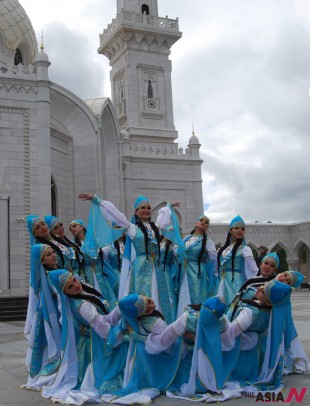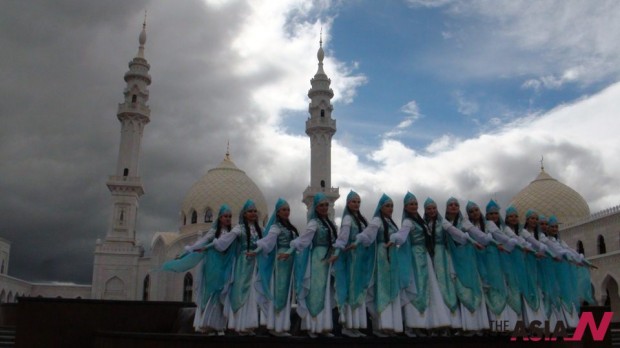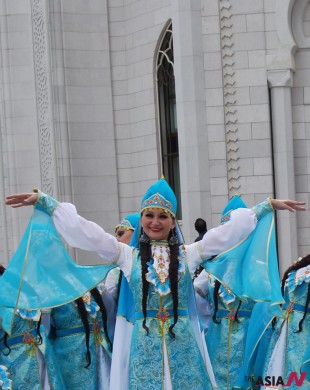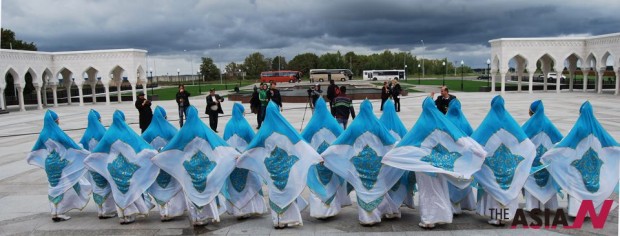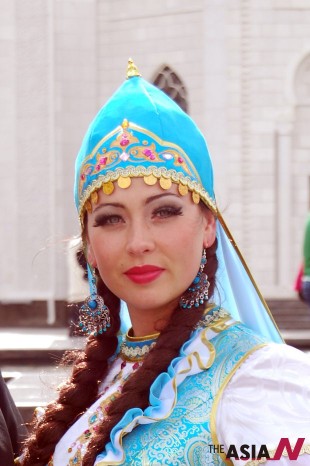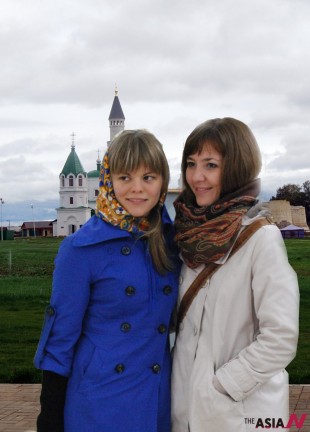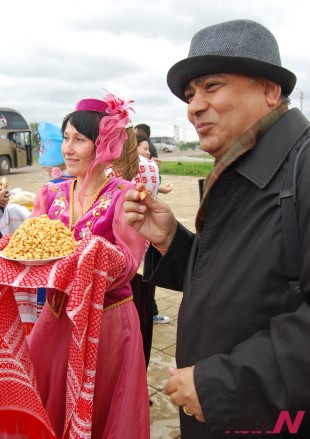Trip to Bulgar following the footsteps of Ahmad bin Fadhlan who first taught Islam in the land
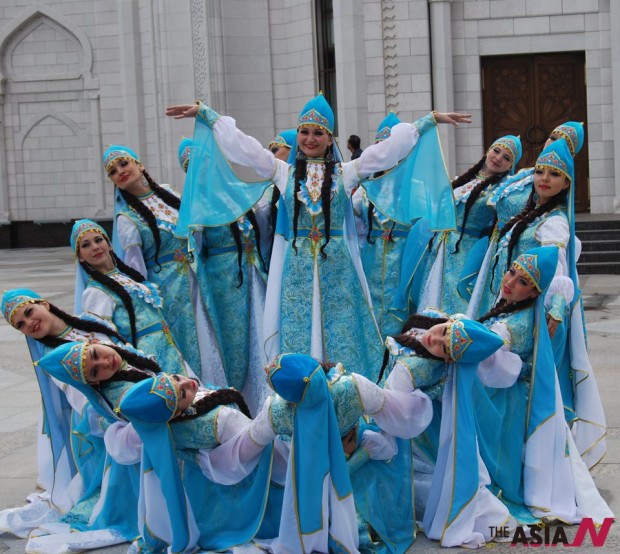
Tatar girls dressed in sky-blue clothes waiting for us in the village of Bulgar on-the-River Volga, making eurhythmic movements.
In front of the White Mosque in the village of Bulgar on the River Volga, Tatar girls dressed in sky-blue clothes were waiting for us, making traditional eurhythmic movements. Historical clothes, vast expanse, severe cold and different faces returned me more than a thousand years back, as if they were historical celebrations. It was here that Ahmad bin Fadhlan set foot on as an envoy of the Abbasid Caliph to teach the people of that land about Islam, which made their descendants define the date of the arrival of that Arab as the birth of the true religion in the Tatar nation.
With me now there is the journey edited, commented on and introduced by Dr Sami Aldahhan and published by the Arab Scientific Academy in Damascus. It is entitled “Message of Ahmad bin Fadhlan – Ahmad bin Alabbas bin Rashid bin Hammad Describing the Journey to the Lands of the Turks, Caspians, Russians and Slavs,” AH 309 (AD 921)
Ahmad bin Fadhlan evidently set out on his journey from Baghdad. As he was heading towards the location of “Bulgar” on the Volga where the present historical village in Tatarstan, one of the Islamic republics in the Russian Federation, lies, he had to head north for a distance of more than 2,500 km. Accordingly, the first question that crossed my mind and I tried to find an answer to was why his caravan doubled the distance as bin Fadhlan headed east before heading back north west.
That was one of the questions that kept flashing into mind as we ponder about the beginning and even enquire how that king living in the extreme north learned about the Abbasid Caliph and sought his guidance on worldly and religious matters and his material assistance to build a fortress to defend him against his enemies and asked him to send somebody to teach his people about Islam.
The Caliph’s Baghdad
In AH 295, Almuqtadir Bellah Abul Fadl Jaafar, son of Caliph Almoatadid, was recognized as an Abbasid Caliph in Baghdad. As he was only 13 years old then, his courtiers were able to make him so spendthrift that he had 11,000 Byzantine and Sudanese eunuchs, and his safes were full of jewellery and precious stones. It was even rumoured that his government was only concerned with providing women and servants, and according to some historians he wasted 70m dinars, apart from government expenses, and to appease soldiers and slaves he had to sell his farms, furniture and gold ware. He was dethroned, then reinstated and killed and his body remained on a roadside in AH 320, as mentioned in Aldahhan’s text editing of the journey.
Apparently, that state of affairs had a negative image, so how did the “media” image from the outside look different and bright? In his book “Experiments of Nations,” Ibn Miskaweh describes the conditions of Baghdad in AH 305, i.e. four years before the start of Ibn Fadhlan’s journey:
“In AH 305, two envoys of the Byzantine king arrived in the City of Peace (Baghdad) on the Euphrates carrying many valuable presents on Monday the second of Almuharram. They stayed in Said bin Mikhlid’s house, and Abulhassan bin Alfurat (a Caliph’s minister) offered to furnish the house and provide all household equipment and materials. The envoys and their companions were also provided with wide accommodation and many animals and sweets… The two guests requested an audience with Almuqtadir to deliver the message they carried, but they were told that was only possible after seeing his minister and asking him for facilitating the audience with the Caliph. Abu Umar Odday bin Abdul Baqi, who accompanied them from the border, asked Ibn Alfurat to grant them the audience, and he promised that to be on a date he specified.”
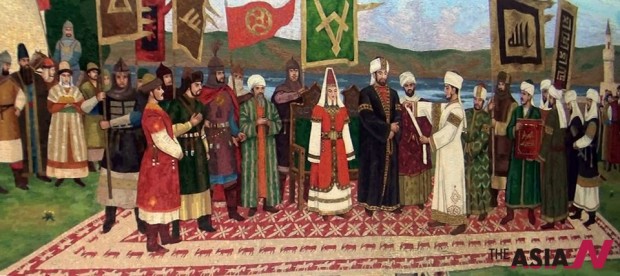
Ahmad bin Fadhlan reads the letter of the Abbasid Caliph Almuqtadir to the king of the Slavs in the Volga Bulgar, Almish bin Yiltawar. Flags carry “Allah” and “Tashahhud”. The museum houses portraits depicting bin Fadhlan’s journey, times and thereafter.
Continuing the description of the drama of the two envoys’ audience with the Caliph, Ibn Miskaweh writes: “The minister arranged for the army to line up from Said’s house to his house at Almukharram, and for his slaves, soldiers and the veiled in his house to line up from the house door to his divan. A magnificent assembly room with a golden ceiling was prepared for him in Albustan House and was profusely furnished, carpeted and curtained at a cost of 30,000 dinars. A high prayer rug was put as a headrest for him. Servants stood in front, behind and to the right and left of him. Commanders and associates filled the courtyard. When the two envoys were admitted they saw soldiers and a crowd on their way, which surprised them greatly.”
After this description of what the two envoys saw in the lobby, whom they met in the house, what they looked at in the assembly, what they heard from the minister’s interpreter, who promised them to seek an audience with the Caliph, was the appointed day. Elegantly dressed soldiers lined up from Said’s house to Alsultan Housa, and the envoys passed through the house courtyards, lobbies and corridors filled with men and soldiers and proceeded to a corridor which led to a courtyard, then a further corridor and courtyard until they were sick with walking and surprised at the large number of soldiers and weapons”. Then they were admitted to see the Caliph who was sitting on his throne, surrounded by associates standing in order of rank. When the envoys entered they kissed the floor and stood where the chamberlain told them to. They delivered the message and the minister replied. The audience ended and each envoy was given a gift of 20,000 dirhams and they left the country with the interpreter.
After this picture which carries tales circulated through the Silk Road, do we enquire what was on the mind of the king of the north when he sent something to the Caliph? As this picture influenced the creation of the king of the north’s image of Baghdad, it made Ibn Fadhlan, who came from the capital of luxury and civilization, underestimate what they saw and arouse surprise at the life of the Slavs, inhabitants of the north in Europe on the edge of the Volga whose capital is near Kazan today.
Getting out of Kazan
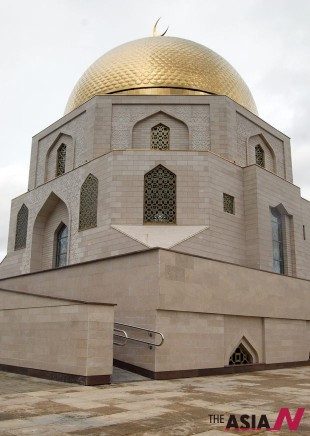
Taking the form of a separate dome, the museum’s shape is inspired by documented old architecture in artistic and lithographic forms; a recreation of classical architecture. It seems that fur, wooden and stone domes were known. In his diary of the journey Ibn Fadhlan wrote: “When he saw us he prostrated himself in praise of Almighty Allah and threw dirhams from his lseeve and ordered tents to be put up for us to stay in.”
It was raining heavily and at times drizzle fell on the front of the bus which drove us in the early morning from Kazan, the capital of Tatarstan, to the historical village of Bulgar. The Volga was not the only river that we passed by and went along, as there is another river we left behind – Kazanka. Had our journey not been by land we would have reached through the River Kama which in places looks as wide as a sea.
We were then on our way to the Bulgars, and our guides, by turns, talked about the journey: Mrs Raissa Gariva, who loves the historical area, Dr Nouriyya Krayeva, who talks about Ibn Fadhlan’s journey and interpreter Roushanch Afifa, who visits the area like me, for the first time.
I hardly know now why Ibn Fadhlan’s journey took a circuitous route. He and his caravan went along the Silk Road, as Kazan’s strategic location put it on the road of trade caravans. The carpet which merchants carried in the 7th and 8th centuries helped the Volga basin to communicate with the East, including Islamic Arab republics and identify their customs and religion.
That allowed the king of the Volga Bulgar, Almish bin Yiltawar to found the first Muslim kingdom in north-eastern Europe and request Caliph Almuqtadirbellah to send a mission to teach him about religion and Sharia and build a mosque with a minbar to pray for the Caliph on, as well as to build a fortress to defend him against adversary kings. Although the Bulgar king was rich – according to Ibn Fadhlan – he said the Caliph’s money was intended for blessing, out of his regard for their state. Travellers reported that the Caspian kings – who were Jews – were the king’s enemies and used to assault and even levy taxes on the people and take sable skin from every house in the kingdom by force. The Caspian king’s son was so aggressive that he could marry any of the Slav king’s daughters by force, though he was Muslim!
Before entering Ibn Fadhlan’s Museum, which has an external space and internal buildings, we saw excavations carried out of old buildings, some of which apparently were only a hundred years and not a thousand years old as the excavators hoped.
We sheltered from the rain under umbrellas and the fierce wind swept us. What a cruelty as it was still autumn and I was told temperature in winter fell to –40˚C! As I crossed the museum gate I, surprised, wondered whether Ibn Fadhlan arrived in winter or summer!
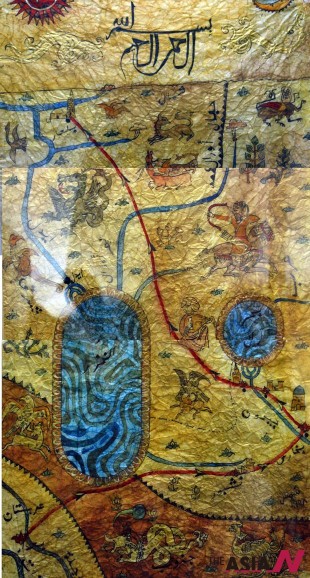
A rare map, published for the first time, from a portrait in Ahmad bin Fadhlan Museum. Islamic caliphate cities in and around Baghdad were called Arabistan. The map shows the direction of the caravan east in Bukhara (present – day Uzbekistan) before changing its route to the north west.
Ibn Fadhlan’s delegation
In point of fact, the delegation left Baghdad before summer: on Thursday, 11 Safar AH 309 (21 June 921) and travelled east and north passing the mountain region, then Hamadan and Rei (near present-day Tehran, the capital of Iran) and crossed Amu Darya River to reach Bukhara, then returned west through forests and deserts until he reached the seat of the king of the Slavs on the Volga on Sunday, 12 Almuharram AH 310 (11 May 922) after an eleven-month journey.
He did not escape the biting cold at Urgench on Amu Darya River which was so bitter that his beard froze as he got out of the bathroom, and in an inner house he wrapped himself in warm clothes and fur, but the extreme cold made his cheek stick to the pillow!
Now only, as I am reading about the extreme cold everything has become clear to me. Before the journey, Mrs Zilia Valiva, the Deputy Prime Minister and supervisor of the Kremlin museums in Kazan, invited me to visit the exhibition of Tatar traditional culture where all the many clothes were for winter, as if summer had no appointment with fashion designers here!
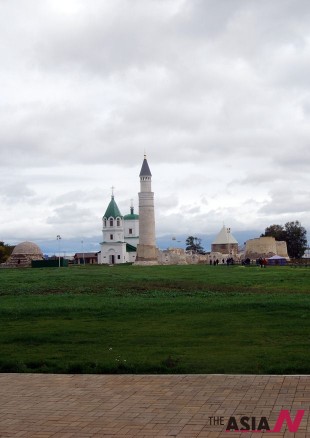
Tolerance is the epitome of the relationship between Islam and Christianity. A church is seen in a city like this one which celebrates the anniversary of the adoption of Islam. It also means that Islam embraces the followers of other religions and recognizes the right of the faithful to perform their rituals.
The Caliph’s delegation consisted of four members: Ahmad bin Fadhlan, who was charged with teaching; Sawsan Abassi, Nazir Alharmi’s companion; Takin, A Turk and Pars, a Slav. They set out on their journey to Baghdad with Abdullah bin Pashtu of the Caspian, the Slav king’s envoy. What surprised me was that the king sent a man of Caspian origin seeking the help of the Abbasid Caliph against the Caspians! As Aldahhan explains, he was chosen because of his knowledge of Arabic and trust in him and his religiousness. Two members of the delegation spoke Russian: the first, Sawsan, was taken as a slave from Russia, then learned Arabic and became a devout Muslim; the second, Pars, whose name and ancestry show that he was as Slav. The third member, a Turk, mastered the Turkic languages of the countries the delegation passed on their way to the Volga. He was a blacksmith in Chorasmia (Khwarazm).
The languages the delegation members spoke made up for Ahmad bin Fadhlan’s ignorance of foreign languages. But, was he qualified to accomplish the mission he was dispatched on: Islamic law. The journey’s reader knows that he was fully in charge during it, but the delegation included servants, assistants and teachers as well, and it is worth noting that besides money the delegation carried medicines for the Slav king, which reflected Baghdad’s grandeur and the skill of its scientists and doctors.
We are standing now in front of the map which shows the place Ibn Fadhlan arrived at and where the delegation was received by the four kings under control of the king of the Slavs, together with his brothers and children carrying food. (We were also received by Tatar girls who offered us chukchuk sweets and hot bread). As the king saw the delegation he prostrated himself, praising Almighty Allah, and threw dirhams from his sleeve on the delegation and ordered tents to be put up for them to stay in.
We visited the museum and were astonished at the mixture of old and new. Some lithographic paintings which I saw in the Kremlin Museum are printed and hung here. There are manuscripts in Arabic and others in Arabic-letter Tartar. As the rain let up, that allowed us to visit an old Tatar house, the same place where a truly historic banquet was given to Ibn Fadhlan. The wooden house was filled with warmth, and traditional songs were performed on a small stage in front of the huge banqueting table.
The presence of horse meat on the table cut into thin slices similar to brown bread ones surprised me. It is said that serving horse meat for a guest is a sign of rare Arabian hospitality. They were astonished when I told them that we don’t eat horse meat, and were further astonished that we eat pigeons, which they don’t. The little oddities which we saw were big wonders for Ibn Fadhlan a thousand years ago.
In front of a large mural of him, the king received Ibn Fadhlan and listened to him read the king’s message. I pondered on Ibn Fadhlan’s text: “I began reading paragraphs from the early part of the letter until I reached (Peace be upon you as I praise Allah who there is no God but Him) and asked him to return the Caliph’s greeting, which he and all those present did. The interpreter kept translating word for word, and when the letter finished all those present said Allahua Akbar in a ringing voice.
Next, I read the letter of minister Hamed bin Alabbas while he was standing. I then ordered him to sit down, which he did upon reading the letter of Nazir Alhharmi, whose companions threw many dirhams on him upon completion of the letter. Then I gave him and his wife presents – perfume, clothes and pearl–piece by piece. I publicly bestowed clothes on his wife, who was sitting beside him. That was their custom and dress. Women threw dirhams on her, and finally, we left.”
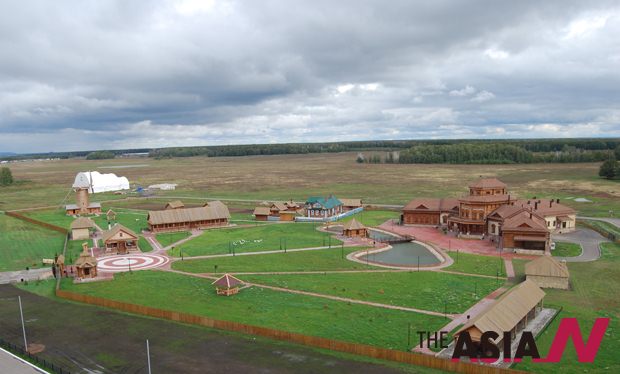
The village of Bulgar lies on the western bank of the Volga. The administrative centre and the smallest town in Spask region, it is 140 km from the capital Kazan, 11 km2 in area, with a population of over 9,000, and a short distance from the historical village of Bulgar, the capital of the Volga Bulgar state. The present village of Bulgar was founded in 1781 named Spask. It was named Kuibyshev from 1935 to 1991. Today, with the restoration of the Islamic identity Bulgar has become like the 10th century historical capital as it was mentioned in the historical records of the Arab traveller and historian Albalhi in AD 920. Ibn Fadhlan’s caravan from Baghdad arrived in the village in AD 922.
Oddities and wonders
Describing a previous journey I said that light clouds surprised me upon my arrival in Tatarstan in the dead of night. That surprised Ibn Fadhlan as well:
“The day there was very long. It is long and the night is short part of the year, then the other way round. On the second night I sat outside the tent and looked at the sky and I saw only a few scattered stars – about fifteen. The red twilight before sunset never disappears and the night is not very dark.”
In addition to what he saw in the sky Ibn Fadhlan was surprised at plants and trees:
“I went somewhere with the king, and my companions Tekin, Sawsan and Pars and one of the king’s companions went through trees where we saw a small green stick as thin as and longer than yarn with a green vein on which a broad leaf spread on the ground like sprouts and contained seeds anyone who eats it no doubt realizes that it is sweet pomegranate. We ate a lot of it which was really delicious. I saw very green apple which is more acidic than wine vinegar drunk by slave girls, which makes them gain weight. I saw many hazel trees covering forty groves. I also saw a tree whose name I don’t know. It’s quite long, its trunk smoother than paper, its heads are similar to palm ones with thin fronds. They bore a hole in a specific place on the tree trunk and put a container under it to collect water sweeter than honey.”
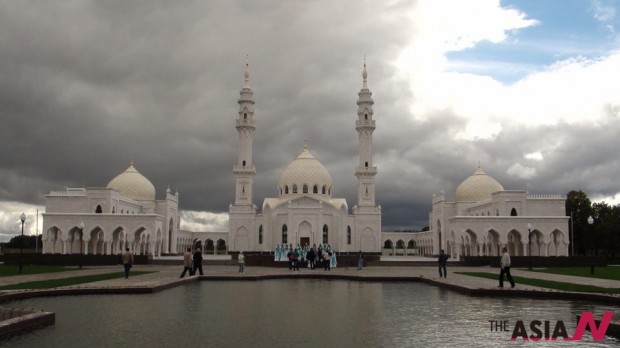
In the village of Bulgar, and to celebrate the 1123th anniversary of the village’s adoption of Islam, the AK Masjid (Michit) (the White Mosque) was opened and built on the same place where the Volta Bulgar adopted it in AD 922. According to the Tatar ex-president Mintimer Shaeymiev, the mosque’s architecture is inspired by that of the Prophet’s Mosque in Medina.
I followed Ibn Fadhlan’s tales about the strange creatures he saw or heard about in zoology books, particularly the wide desert near the Slav kingdom in which he said he saw an animal smaller than a camel but bigger than an ox, with a camel’s head, an ox’s tail, a mule’s body, and ox’s hoofs. He has a round, thick horn in the middle of his head which becomes like the teeth of a spear when it rises. It’s more or less 3-5 cubits long. It feeds on lush green leaves. When it sees a knight it moves towards him. If he is mounted he feels hardly safe, and if it reaches him it pulls him from his back with its horn and throws him into the air ad catches him with its horn and kills him. It does not hurt the horse. It is chased in the desert and woods to kill it. Poisoned spear throwers climb the tall trees where they find it among them to kill it. In the king’s residence I saw three large wild cows which looked like Yemeni onyx I was told they were made of the horn of that animal which some natives say it is the rhinoceros”.
This description which comes in the context of the journey applies to the rhinoceros with thick wool which became extinct in the Ice Age and lived in Europe and Asia where it disappeared because of climate change and game hunt. Only a few survived and may face the fate of the mammoth. It could have been the musk deer which existed 30,000 years ago.
We heard the high sound of Tatar traditional songs as if swords had been rattling in celebration of the arrival of Ibn Fadhlan. The Muslim kingdom continued to expand and Kazan became its capital. When we compare its peaceful adoption of Islam with Ivan the Terrible’s bloody invasion in the 16th century after six centuries of safe living, blowing up its walls and killing its soldiers, as portrayed on a portrait in the national museum.
I went to the river where it was still raining heavily. We crossed to a mosque which houses the largest copy of the Quran in the world, according to Guinness World Records. The Tatars wish to affirm their belonging to Islam by all means. They adhere to its traditions and add their touches to it which affirm their devotion to religion and interest in life to develop it for future generations.
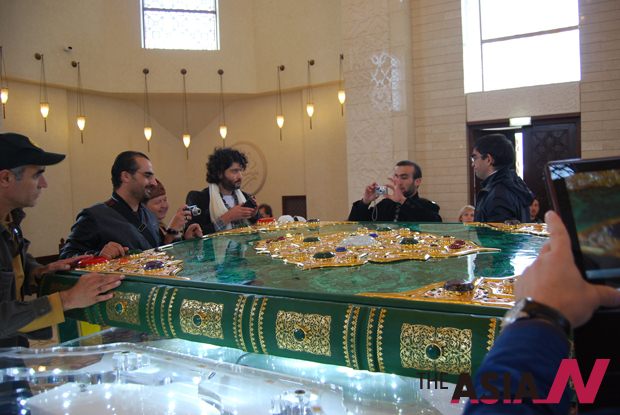
Museum visitors take photos of the rare 2m high, 152cm wide and 6.96 in thick copy of the Quran, printed by Nedjan Bratasevec and Andrej Carnatic (Slovenia) and Mauro Loce (italy). It was presented by the Republican Foundation for the Revival of Historical and Cultural Monuments of the Republic of Tatarstan (Russia) to the Kul-Sharif mosque in Kazan on 17 November 2011. A Guinness World Records certificate of the largest printed copy of the Glorious Quran



















